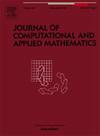A method for solving ill-conditioned separable nonlinear least squares problems and its application
IF 2.1
2区 数学
Q1 MATHEMATICS, APPLIED
Journal of Computational and Applied Mathematics
Pub Date : 2025-02-28
DOI:10.1016/j.cam.2025.116624
引用次数: 0
Abstract
For ill-conditioned separable nonlinear least squares problems, the LM (Levenberg-Marquardt) iteration method based on the VP (Variable Projection) algorithm and SVD (Singular Value Decomposition) for solving nonlinear parameters is explored in this paper, and a ridge estimation is proposed based on the TSVD (Truncated Singular Value Decomposition) and MSVD (Modified Singular Value Decomposition) methods to solve linear parameters. It is proved that the LM method based on SVD and the improved algorithm based on TSVD and MSVD can overcome the ill-conditioning of the matrix to a certain extent and enhance the reliability of parameter estimation through Mackey-Glass time series simulation and height anomaly fitting experiments. TSVD, MSVD and improved algorithm are compared and analyzed in terms of the accuracy and stability of parameter estimation and the curve fitting effect in the Mackey-Glass time series simulation experiment. The height anomaly fitting experiment verifies the feasibility and applicability of the algorithm in such practical problems. The experimental results show that the improved algorithm based on TSVD and MSVD enables the parameter estimation to be more stable, and the parameter values calculated by the algorithm bring about a better goodness of fit and fitting effect of the model.
病态可分非线性最小二乘问题的一种求解方法及其应用
针对病态可分非线性最小二乘问题,研究了基于变量投影(VP)算法和奇异值分解(SVD)算法求解非线性参数的LM (Levenberg-Marquardt)迭代方法,并提出了基于截断奇异值分解(TSVD)和修正奇异值分解(MSVD)方法求解线性参数的脊估计。通过Mackey-Glass时间序列模拟和高度异常拟合实验证明,基于SVD的LM方法和基于TSVD和MSVD的改进算法能够在一定程度上克服矩阵的病态,提高参数估计的可靠性。在Mackey-Glass时间序列仿真实验中,比较分析了TSVD、MSVD和改进算法在参数估计的准确性和稳定性以及曲线拟合效果方面的优劣。高程异常拟合实验验证了该算法在此类实际问题中的可行性和适用性。实验结果表明,基于TSVD和MSVD的改进算法使参数估计更加稳定,算法计算的参数值具有更好的拟合优度和模型的拟合效果。
本文章由计算机程序翻译,如有差异,请以英文原文为准。
求助全文
约1分钟内获得全文
求助全文
来源期刊
CiteScore
5.40
自引率
4.20%
发文量
437
审稿时长
3.0 months
期刊介绍:
The Journal of Computational and Applied Mathematics publishes original papers of high scientific value in all areas of computational and applied mathematics. The main interest of the Journal is in papers that describe and analyze new computational techniques for solving scientific or engineering problems. Also the improved analysis, including the effectiveness and applicability, of existing methods and algorithms is of importance. The computational efficiency (e.g. the convergence, stability, accuracy, ...) should be proved and illustrated by nontrivial numerical examples. Papers describing only variants of existing methods, without adding significant new computational properties are not of interest.
The audience consists of: applied mathematicians, numerical analysts, computational scientists and engineers.

 求助内容:
求助内容: 应助结果提醒方式:
应助结果提醒方式:


